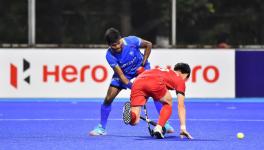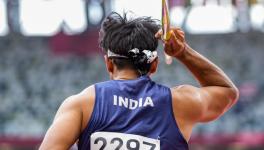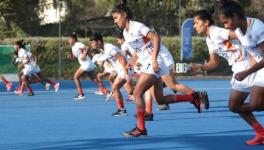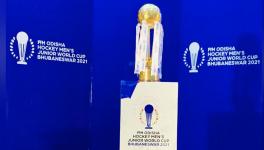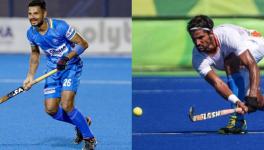FIH Hockey World Cup: India Show Old School Guile and Modern Will in Victory
Lalit Upadhyay (right) of the Indian hockey team, who was adjudged the Player of the Match against Canada, celebrates after scoring a goal (Pic: Hockey India).
Hockey legend Dileep Tirkey would have sported a smile with a tinge of deja vu after the Indian hockey team sealed a quarterfinal spot in the FIH Men’s Hockey World Cup with a 5-1 victory over Canada in the final Group C match at the Kalinga Stadium in Bhubaneswar. While the win on December 8, and the progress into the tournament knockouts as toppers of the group ahead of Olympic silver medallists Belgium, brings with it its own joys, Tirkey would have felt a more personal connect in the match thanks to Amit Rohidas.
In the 51st minute, the defender from Odisha scored India’s fourth goal from a penalty corner, executing a heartening variation, one of the many coach Harendra Singh employed through the match as promised. This particular penalty corner variation was not a complex iteration of the robotically efficient and equally impersonal drag flick, but a throwback to the old days — a full blown hit. Tirkey was an exponent of the hit from short corners, and was India’s go to PC specialist during his career with the national team in the late 1990s and early 2000s.
Read More | FIH Hockey World Cup: Group Deciders at Different Times Could Kill Fair Play
Tirkey was one of the last practitioners of the penalty corner hit, a dying art by then with the Sohail Abbas-Taeke Taekema drag flick revolution firmly ensconced and underway.
Fast Forward to 2018, with teams devicing many ways to stop the dreaded drag flick, hockey tacticians across the world are trying to devise new means to get the better of the cavalry charge of defenders, which has become more measured and precise of late, thereby cutting angles quite drastically for the drag flicker to effectively unleash his bombs.
Like the rest of the world, Harendra Singh’s India — with three drag flick specialists in the mix (Harmanpreet Singh, Varun Kumar and Rohidas), and with former Aussie specialist Chris Ciriello as one of the analysts — have also been trying various permutations to crack defenses. It is a given that Rohidas’ variation would surely have not come from Ciriello’s modern bag of tricks. It would have, most likely, been taken out from one of Harendra’s old battle-worn notebooks of tactics.
The smart one pulled on the Canadians, a blast from the past, was beautiful in its simplicity. The push from Akashdeep Singh was trapped by Nilakanta Sharma for Rohidas, whose initial action was similar to the one he employs while coiling up for a drag. Defender Iain Smythe rushed in to block the inevitable. However, to the Canadian defender’s horror, Rohidas gently dabbed the ball to the right, took a long step to line up the hit, and let it rip diagonally towards goal, beyond the reach of goalkeeper Antoni Kindler.
The success of this PC hit means Indians are likely to use this variation in the future, an additional variable, a spanner in the opposition’s defense machinery so to speak. Like how retro fashion makes occasional comebacks into haute couture, one was left wondering whether we just witnessed the first steps in the return of the PC hit into modern hockey.
Video | FIH Men's Hockey World Cup: Dutch Hopes, Argentina's Scope and India Under the Microscope
Perhaps it is too early to juxtapose the penalty corner hit into hockey’s evolutionary graph. Nonetheless, the fact that fast-paced modern hockey still has scope for some tactics from yore (remember how India employed the scoop to bypass the tight Belgian midfield and score), is adding some charm into the game.
Having said that, India’s variations, promised by coach Harendra were not just limited to the vintage. The boldest of his moves against Canada — though it was not under any risk or desperation — was the introduction of Harmanpreet as a kicking back in place of goalkeeper PR Sreejesh in the dying minutes of the match.
India led 5-1 then, and, Harmanpreet’s introduction was intended to give the defender, and the team, a taste of the tactic (playing with no goalkeeper with an outfield player taking over the role) which India may need if a desperate situation arises in the matches ahead.
Harendra even said that he wanted to employ the kicking back much earlier in the final quarter.
Read More | Golden Freedom: Legacy of Independent India’s First Hockey Olympic Gold in 1948
“I wanted to put him (Harmanpreet, the kicking back) in when it was around eight minutes left to play. We had a good lead by then. But I would have done it even if the score was 2-1,” he said after the match.
A kicking back for eight minutes when the score is 2-1 would have been a very bold move, bordering foolishness. Then again, India had every right to feel adventurous in the match after the Belgians made things easier for them. The European team won 5-1 against South Africa earlier in the day, which took them on level with India as far as goal difference is concerned. The Indians needed just a one-goal win to progress.
That freed Harendra with a lot of room for bold tactics, and retro variations. The Canadians helped further by starting the fourth quarter laden with inertia. The scores were tied 1-1 at the time. India stepped it up, Chinglensana Singh struck to add to the opening goal in the first quarter by Harmanpreet Singh, Lalit Updadhyay scored two, Rohidas did a Tirkey, the Canadians buckled. Quarters ahoy!
Get the latest reports & analysis with people's perspective on Protests, movements & deep analytical videos, discussions of the current affairs in your Telegram app. Subscribe to NewsClick's Telegram channel & get Real-Time updates on stories, as they get published on our website.











